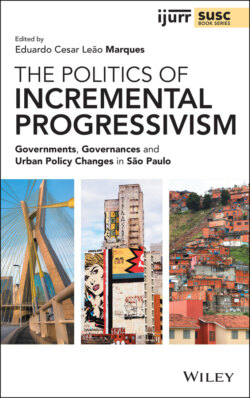Читать книгу The Politics of Incremental Progressivism - Группа авторов - Страница 16
City Studies, International Comparisons, and Urban Theories
ОглавлениеThis book is a city monograph with nested comparisons between policy sectors mainly within this city. However, it departs from a comparative ontology and forms part of a broader international comparison between Paris, London, Mexico City, Milan, and São Paulo.5 The production of city comparisons has moved to the forefront of contemporary international debates (Robinson 2011), attaining general acceptance among urban scholars. Essential agreements were also reached about the importance of avoiding the imposition of theoretical models produced solely from cases in the Global North (Scott 2012). The consequences of comparisons for theory production, however, remain contested, leading to polarized debates between generalizations in urban theory (Scott and Storper 2015) and about postcolonial ontologies (Roy 2016).
In an unusual convergence, political science has also been revitalizing its approach to comparisons. Nation‐state comparisons are a classic subject of studies in comparative politics (Evans et al. 1985; Levitsky and Roberts 2011) and methods (Tilly 1992; Ragin 1987). The field has also compared cities for a long time (Ruchelman 1969; Ferman 1985), as well as subnational variations more recently (Weitz‐Shapiro 2014). Lately, however, comparisons between multi‐scales in different countries (Pasotti 2010b; Holland 2018a) have also been incorporated in what Giraudy et al. (2019) call subnational research (SNR) and Sellers (2019) transnational comparisons. In this case, variations in national features may be simultaneously analyzed with local processes and with the connections between national and subnational politics (Sellers and Kwak 2010), renovating our models about political processes and avoiding theory stretching (Giraudy et al. 2019).
Reviewing the positions of these debates lies way beyond the scope of this introduction, but it is important to state our substantive point of departure vis‐à‐vis comparisons and theory building, to make clear our claims of generalization from São Paulo.
This book adopts a one city‐many‐policies design, studying one of the most important megacities in the world with democratic institutions recently consolidated within a federalist and highly unequal late‐industrialized country. In this sense, although all these features are present in many other places, their combination is unique. Consequently, we by no means consider São Paulo representative of Southern cities or metropolises, nor its political institutions as examples of local governments. However, our subject – urban politics and policies – mainly involves the same types of actors and processes present everywhere, even if produced by different historical processes and embedded in diverse contexts. As in any large metropolis, State and non‐State actors such as politicians, political parties, bureaucracies, private companies and community organizations interact strategically to make their interests prevail and to influence policies. Since these actors occupy homologous positions in political relations worldwide, it is reasonable to deduce that their interests have the same natures. Similarly, institutions (and policies themselves) frame politics and influence behavior as in any other city. These commonalities could lead us to search for a universalizing logic of theory building, or at least a variation‐finding one (Tilly 1992), moving toward the production of one single generalizable theory of urban politics.
On the other hand, it is also true that these actors, institutions and processes have quite different features and appear in varying combinations due to the specific historical processes that produced their States, societies and cities. Radicalizing the argument, for example, large cities of the North are studied with a focus on planning, technical capacities and substantive agendas of strong political parties. At the same time, Southern metropolises are usually characterized by the literature in terms of corruption in State contracts, the prevalence of clientelism, the absence of party ideology, or, contradictorily, by vivid civil society dynamics. These differences could persuade us to accept the presence of ontological differences, making knowledge produced from the South substantively different from the kinds produced elsewhere. This would mean that theories have merely regional validity, or, in a more radical version, that theorization is impossible.
We believe that both these epistemological positions are partly right (and wrong). There are commonalities in processes and actors, but also particularities that must be considered. Many features of Southern cities indeed challenge traditional interpretations, but it is also true that what happens in the former has the same nature of what happens anywhere. This implies that such differences are not ontological. At least for urban politics and policies, the incorporation of Southern cities as ‘normal’ cases – that is, capable of being understood by mobilizing the same elements as other cities – brings into consideration the full variation of the phenomenon in question (local institutions), thus contributing to substantially broader theories, but not substantively different ones.
This book sets out, then, from the understanding that comparisons will not lead to a theory of general validity, but to elements and processes that explain specific classes of cases through their (historically constructed) combination. In this case, the search for generalization is based not only on multiple conjunctural causations (Ragin 1987) in which several causal mechanisms operate together but especially on plural causality (Pickvance 2001) in which groups of causal mechanisms operate differently in different subclasses of subjects. The challenge becomes how to explain not only variation (considering general claims) but more particularly the variation in the causal mechanisms themselves between groups of cases.
This task calls not just for comparisons in general but for detailed comparisons of widely different settings, such as between Southern and Northern metropolises. Similarly, this comparative goal can only be achieved from detailed knowledge of the processes and actors involved, as well as their order and combination, which requires dense case study designs (Ragin 1987). By combining these features, our analysis intends not only to explain the trajectory of urban policies in São Paulo – and especially the construction of redistributive policies – but also to elaborate an analytical framework with actors, processes and governance patterns that can be used, tested and expanded in other large metropolises worldwide.
